Table of contents
- Yamaha SR 500 Model check, used advice, history
- More flywheel for better pulling power
- Wonderful kickstart myths
- The engine is always unabashed
- Up the reference mountain easily with 100 things
- The 2J4 became the 48T
- Yamaha SR 500 as a travel vehicle
- Back to stress-free driving pleasure
- From 1991 single cylinder only with 23 hp
- The technology
- Facelift
- Used check
- Market situation
- Technical specifications
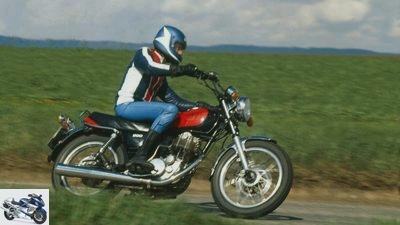
archive
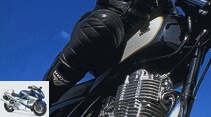
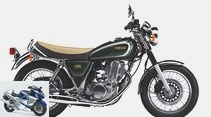

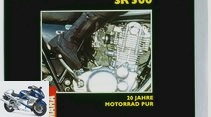
24 pictures
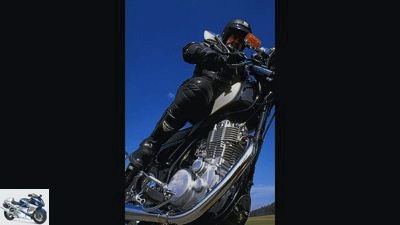
archive
1/24
35 years ago, the SR 500 marked the opposite pole of the performance craze with its half-liter single.
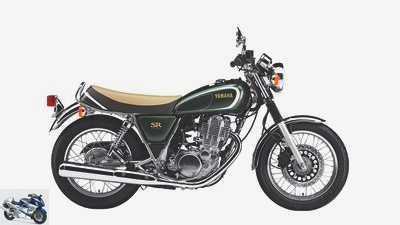
Yamaha
2/24
35 years of Yamaha SR – in Japan this is celebrated with a special model of the 400 series that is still available there. The SR 400 35th Anniversary model has 26 hp and costs the equivalent of almost exactly 4,000 euros. Yamaha is currently considering offering the SR 400 in Europe. It could already be seen in November at the EICMA in Milan and be available for purchase in this country in spring 2014.
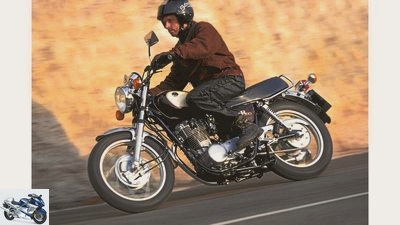
archive
3/24
1991-1999: 1991 Reduction of the series output to 23 HP, dethrottling only possible to 27 HP. From 1992 only with front drum brake, from 1993 with side stand breaker switch. 1999 (picture) last official sales year.
Power: 23 or 27 hp
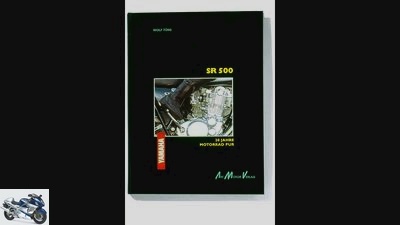
archive
4/24
The book about the bike: the history of the SR 500 by Wolf Tons.
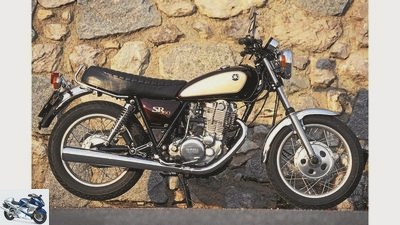
archive
5/24
Price 1999: 7,995 marks.
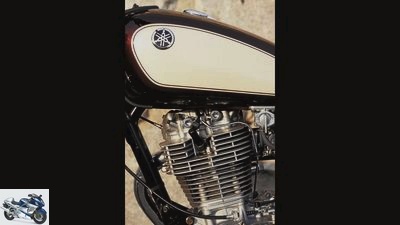
archive
6/24
Problems with defective valve trains caused Yamaha to react: from 1984 an additional oil riser line supplies the exhaust valve, which is subject to higher thermal loads.
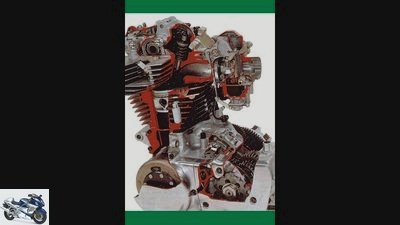
Yamaha
7/24
The nicely ribbed, air-cooled, simple two-valve single pays homage to the classic engine design.
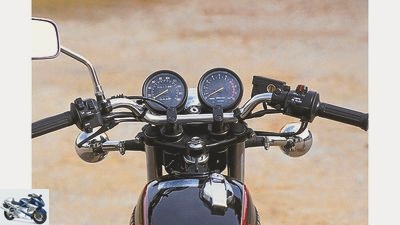
archive
8/24
… The pilot now wriggles less in the airstream.
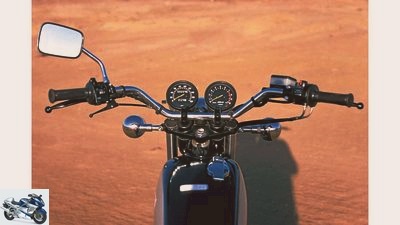
archive
9/24
The wide and high handlebars had to give way to a narrower, flatter part in 1984 …
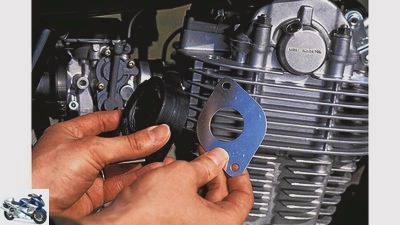
archive
10/24
Intake manifold without perforated screen for a full 27 instead of 23 hp.
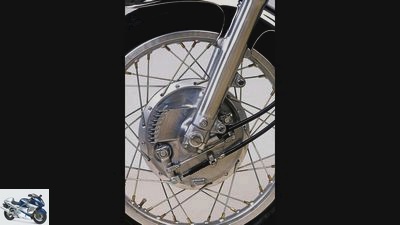
archive
11/24
Classic look, moderate effect: the duplex drum brake.
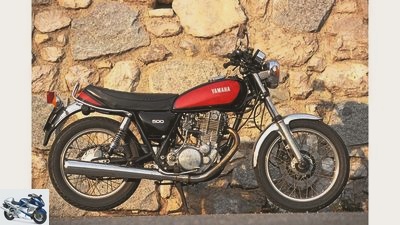
archive
12/24
1978: The original model, type 2J4, with a 19-inch front wheel enters the scene at a price of 4,491 marks. The slightly modified motor of the sister XT 500 hangs in the reinforced frame. H4 lights and an effective front disc brake are standard.
Power: 27 or 33 hp.
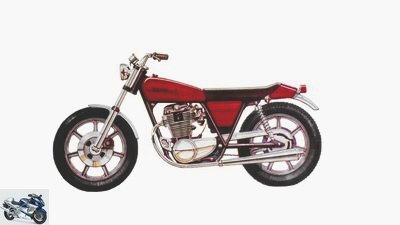
archive
13/24
This sketch was made as early as 1976, two years before the start of series production.
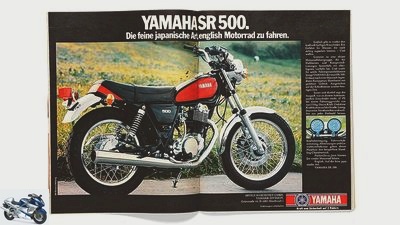
14/24
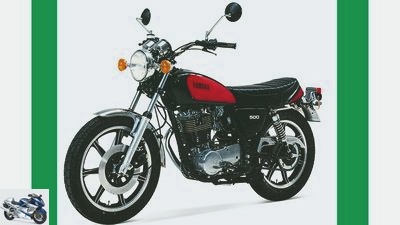
archive
15/24
1979: Cast wheels available for an extra 150 euros, new, larger headlights with a diameter of 200 millimeters, modified cover of the motor housing.
Power: 27 or 33 hp.
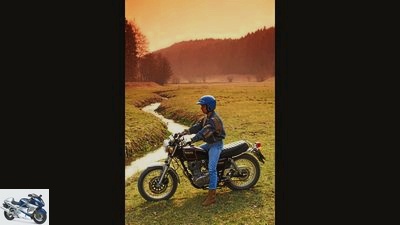
archive
16/24
1984: Model change to type 48T. Now, among other things, with an 18-inch instead of 19-inch front wheel, a smaller headlight (170 mm) and an O-ring chain. Elimination of the plastic sling for the bench.
Power: 27 or 34 hp.
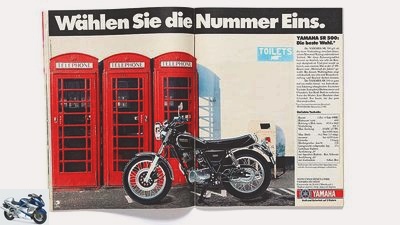
17/24
The right choice for everyone who “wants the pure motorcycle”, according to the 1982 ad.
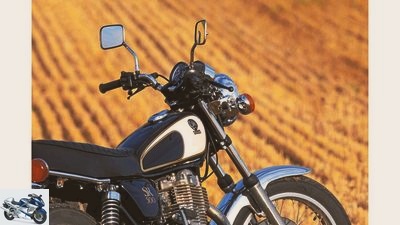
Jahn
18/24
1987: The often criticized small 12-liter tank gave way to a 14-liter model in 1987. From 1988 Yamaha offered a drum brake at the front for an additional charge.
Power: 27 or 34 hp.
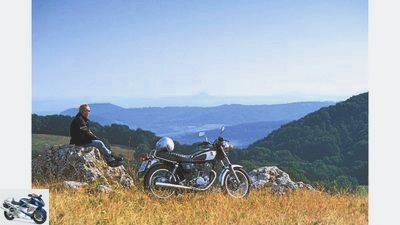
archive
19/24
SR driving decelerates and sharpens the senses for the essentials: Finally the journey is the destination again.
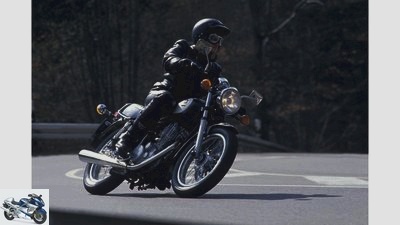
archive
20/24
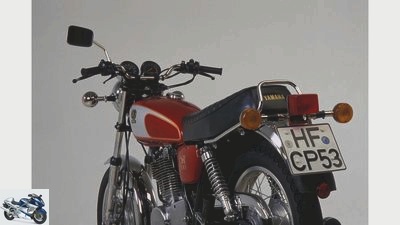
21/24
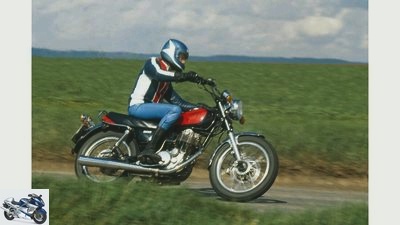
archive
22/24
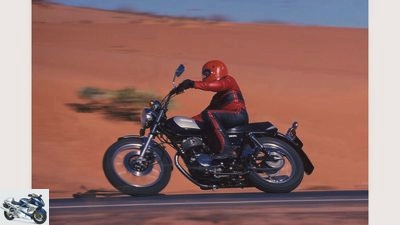
archive
23/24
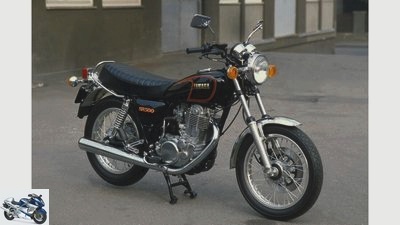
archive
24/24
counselor
Used purchase
Yamaha SR 500
Yamaha SR 500
Model check, used advice, history
Content of
35 years ago, the Yamaha SR 500 marked the opposite pole of the performance craze with its half-liter single. The concept, deliberately reduced to the bare essentials, was the cornerstone of their continued success to this day.
Gerhard Eirich
10/11/2013
Higher, faster, further – the mania for rearmament in the motorcycle market was in full swing in 1978 when some courageous decision-makers and model planners in Japan decided to counter this trend. True to the motto “less is more” they swore at Yamaha the pure driving experience. Fewer cylinders, less displacement, less power – a 500 single-cylinder with 27 hp in a simple tubular steel frame should be enough to enjoy the fun of riding on two wheels – the Yamaha SR 500. You already had the right motor, it was previously in the enduro Chassis and already helped the sister model XT 500 to considerable success.
Buy complete article
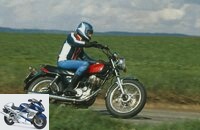
Yamaha SR 500
Model check, used advice, history
8 pages) as PDF
€ 2.00
Buy now
More flywheel for better pulling power
However, they could not and did not want to adopt this completely unchanged, the simple two-valve engine had to endure a few modifications in order to be prepared for the changed area of application. For the Yamaha SR 500 the cylinder and head have larger cooling fins, the piston pin has been lengthened, the crank webs have grown by six to 149 millimeters, and more centrifugal mass should achieve better torque. The clutch basket has been reinforced to withstand higher continuous speeds, the bearing of the shift drum has been modified for better shiftability. Last but not least, a new carburetor was used and the inlet valve grew in diameter. So you didn’t just plug the XT motor into a chassis modified for road use (steeper fork, frame tubes with greater wall thickness and reinforced with sheet metal profiles at the junctions), but effort was made to adapt the machine to the new requirements.
For the German market, the engineers tuned the single-cylinder to an insurance-favorable 27 hp, the unthrottled version of the Yamaha SR 500 made 33 hp at the beginning. If you wanted to convert and have full power available, you only had to install the intake manifold with a larger cross-section and adjust the jetting of the Mikuni carburetor. The basic character of the engine did not change dramatically, but the performance increased measurably: One second faster from zero to 100 km / h and ten things higher are not to be despised. Above all, the translation was now correct, for the 27 hp variant had not been changed and appeared a bit too long, especially in two-person operation or on long climbs.
The add-on parts of the new Yamaha SR 500 are also largely known, as they come from other popular Yamaha models. The fork, handlebar and mudguard, for example, already did their job on the XS 650. Speaking of service: Anyone who wants to shake the single up in the morning and get them active cannot relax and press the button, but must be really physically active with muscle strength and in compliance with an exact preparation of the start ceremony. After all, that too is part of the purist idea.
Wonderful kickstart myths
There were wonderful rumors about the supposedly difficult starting procedure by stepping on the kick starter, horror tales spread at the regulars’ tables, of kick starters kicking back who hurled light drivers in a high arc over the garage roof. Sure, XT and thus also the Yamaha SR 500 were or should be considered real men’s motorcycles. For tough guys, and only to be started by them. Half-hearted attempts to start are said to have also led to injured calves and injured ankles. Stories, some of which have survived to this day, and which have probably contributed to the reputation of the Yamaha SR 500 as a genuine, robust motorcycle.
In truth, if handled correctly, the 500 usually jumped and jumps on the first, or at the latest, on the third step. This is underpinned by the comment in the first test in MOTORRAD: “If the engine doesn’t run on the third step, something is wrong. Either with the single cylinder or the right leg. ”After all, the Yamaha SR 500 makes it very easy for the driver to find the right position of the piston just behind top dead center by means of a window in the top of the right camshaft housing and a white marking on the camshaft. which has to be followed by a “disrespectful step”, whereupon the stew usually begins to work.
The engine is always unabashed
When it comes to expressions of life, the engine has always been unabashed: Its motto seems to be wherever there is burns, it can also vibrate. Balance shaft? There wasn’t. What for? You can and should feel the stew, in different speed ranges with very different intensities. From around 2500 rpm the engine runs smoothly, but just above it, at around 3000 rpm the vibrations in footrests and handlebars reach their first peak. Above that comes the comfort zone, but from around 5500 rpm the vibrations get really rough, but neither the SR engine nor the driver like high continuous speeds anyway. The proverbial thump at the bottom and in the middle has always turned fans of the Yamaha SR 500 on, even if it is subjectively more intoxicating than measurably impressive.
Up the reference mountain easily with 100 things
My first contact with the 500cc steam hammer, at least that was how it seemed to me at the time, also took place sometime in the summer of 1982. Just turned 18 and with a class one and three driver’s license in my pocket, I still drove my 80s, a Honda MT 8. My first car was just around the corner, the Opel Kadett B, a present from my aunt, who got herself a new small car had. The box was completely rusty, but it drove and had MOT. Car and motorcycle at the same time were not possible as a schoolboy, so I gladly accepted the offer of my one year older friend to shoot through the village every now and then with his XT 500 (with an open, crazy 34 hp). The reference mountain at the end of the village, which the eighties managed with difficulty and speedometer 60 in the fourth, easily pulled up the XT with 100 things and still had reserves. Bagged cement, what pressure the thing was!
The XT and its engine quickly lost their reputation. Above all, he supposedly separated the men from the cowards when they tried to start. The previously mentioned horror tales also made the rounds with us. Papperlapapp – our still youthful, energetic urge quickly matured the idea of playing really tough guys. “So‘ ne XT, I’ll throw them at you with my hand. “Big words from stupid boys. But we should be right. With the right preparation (pulling the deco lever, correctly pumping the piston above the top dead center) and applying forceful pressure with the right hand (but not half-heartedly) the project succeeded. At least some of us.
The 2J4 became the 48T
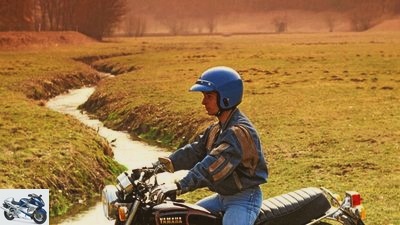
archive
Model change to type 48T. Now, among other things, with an 18-inch instead of 19-inch front wheel, a smaller headlight (170 mm) and an O-ring chain. Elimination of the plastic sling for the bench.
When you talk about the Japanese lady today, you occasionally get uncertain questions: Yamaha SR 500 – isn’t that the one with the huge headlight? Yes and no. The mighty round headlights with a diameter of 200 millimeters were only used in the model years 1979 to 1983. Since the early years of construction were able to boast huge sales figures, these models, with their widespread use, shaped the image of the SR on German roads for a long time. In 1984 not only did the saucepan-sized headlights disappear, after various small changes and improvements (the optional cast wheels from 1979 had proven to be a flop), the first comprehensive model update took place. The type abbreviation also changed – the 2J4 became the 48T, as it was to be called until the end of the construction period.
The smaller 18-inch front wheel improved handling without diluting its stability, and a narrower handlebar replaced the wider, higher sail pole. The plastic rear end disappeared, a grease nipple on the swing arm and an easy-care, more durable chain with O-rings finally found their way. A modified oil control ring should cope with the high oil consumption and an oil riser pipe to the exhaust valve to cope with durability problems with the valve train. A new camshaft with more stroke and the increased volume of the exhaust and air filter gave the engine one more horsepower to the now (open) 34 horsepower. Certainly not decisive for the war, but in view of what was to come from 1991 onwards, a high point in SR history.
Yamaha SR 500 as a travel vehicle

Jahn
The often criticized small 12-liter tank gave way to a 14-liter model in 1987.
For many SR drivers who have come to appreciate their stew as a travel vehicle on long tours, it was much more important to increase the tank volume from 12 to 14 liters (1987), which increased the range to more practicable values. The 500 was never considered to be a swallowing woodpecker – if moved appropriately, it consumes between 3.5 and 4.5 liters per 100 kilometers, over five liters only in extreme cases. Traveling was and is quite possible with the Yamaha SR 500, even with a passenger, who will find an even better padded place from 1984 onwards. Given the payload of around 220 kilograms, there is still room for luggage. Whereby the spring elements, especially the struts, are mercilessly overwhelmed. Most drivers exchanged them for Konis at an early stage anyway. For long-distance trips there are certainly more suitable bikes, one or the other may object. Secure. Not all SR fans are globetrotters.
Back to stress-free driving pleasure
What kind of people are there who drive SR? The stereotype of the poor student who only gets this “bread and-
Butter-Motorrad ”instead of a Ducati, which he actually dreams of, may have happened here and there. But there were and are very different types that mostly made a very conscious decision before they succumbed to the charm of the Yamaha SR 500. Newcomers to MZ two-stroke engines, people with a soul, for whom the single, with a slightly British touch, was completely sufficient, annoyed or overwhelmed multi-cylinder owners who strive back to stress-free driving pleasure. And those frequent drivers and travelers who are capable of screwing and who prefer to repair everything themselves while on the move – and can do so with SR.
In addition, there are, besides those who love the SR exactly as it is, also the hobbyists, converters and refiners who see the Yamaha SR 500 as an ideal basis for the dream of self-construction and turning the classic roadster into a cafe Create a racer, a dirt tracker or whatever kind of individual bike. A very special scene emerged which the legendary Yamaha SR 500 pays homage to in its very own way.
From 1991 single cylinder only with 23 hp
The Yamaha SR 500 could and never wanted to win races in everyday life, but from model year 1991 at the latest, this project was finally a thing of the past. The strict emission and noise regulations forced the designers to take unpleasant measures that stifled the performance of the single to 23 hp. Dethrottling to 27 hp was legally possible in retrospect, but that’s definitely not possible. Owners of younger SR models can only dream of open 33 or 34 hp.

archive
1991 Reduction of the series output to 23 HP, dethrottling only possible to 27 HP. From 1992 only with front drum brake, from 1993 with side stand breaker switch. 1999 (picture) last official sales year.
From 1992 the front disc brake was also omitted, there was only the drum brake, which had already been offered as an option, which was intended to emphasize the nostalgic touch of the Yamaha SR 500. However, this is not a miracle in terms of effectiveness. The last rebellion led to a limited anniversary model in 1998, almost for the 20th birthday. A year later it should be over. At least as a new vehicle in Germany.
The Yamaha SR 500 is still enjoying, or perhaps because of it, still great popularity, this is also reflected in the proud used prices for well-preserved original copies from the first years of construction. As mentioned, it has not been available for sale in Germany since 1999, but it lived on in Japan and is still brand new today as a 400. May the rumors be true that Yamaha is considering making the SR 400 available in Europe in view of its 35th anniversary. The SR fan community, and many who would probably be new to join, should certainly be happy about this. In times of 200 hp racers and 400 kilo cruisers, the existence of such a purist, honest, classically beautiful bike like the SR (regardless of whether it is a 400 or 500) would simply do a good job.
The technology
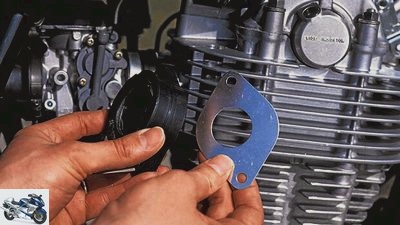
archive
Intake manifold without perforated screen for a full 27 instead of 23 hp.
One of the secrets of the Yamaha SR 500’s success is its technically comparatively simple structure and its ease of maintenance and repair. However, this does not make them free from weaknesses or vulnerabilities. So she doesn’t like continuous full throttle operation or careless maintenance. In general, the single cylinder usually requires an overhaul of the piston, cylinder and often the cylinder head after 30,000 kilometers at the latest.
Defective alternators (until 1983) and vibration damage to numerous add-on parts are also typical of the SR models. Various model maintenance measures, the most important in 1984 when switching from the 2J4 to the 48T model, as well as significant changes to the 1991 model year, brought improvements or slowed the performance of the single. In this way, high oil consumption or defects in the valve train could be largely prevented, until the end the risk of vibration cracks on all possible components and the need to take care of the overstrained spring elements.
The particularly susceptible alternator should long ago have been replaced in older models, but from 1980 it was more stable ex works. It no longer has to be completely replaced (expensive), the pulse coil (usually the source of error) is available individually. Parts or overhauled Limas are available from Motorradtechnik Munich, for example. Speaking of parts and help: There are some specialists and parts suppliers, KEDO, for example, offers spare and conversion parts and accessories, Meinold Muller is in good hands when it comes to engine repairs and parts supply (for all contact details see “Specialists”).
Facelift
1978: Sales start of the master model type 2J4 with 27 or open 33 hp
1979: On request, cast wheels (150 marks surcharge), new, large headlights with a diameter of 200 millimeters, modified engine side cover to secure the shaft sealing ring, cover of the oil pump housing with five instead of three screws, installation clearance of the crankshaft reduced, separate pulse coil for low-speed range
1980: Thicker lower cooling ribs to stiffen the cylinder, reinforcement of the kickstarter freewheel, additional frame plates between the control head and oil filler neck, turn signals attached to the taillight holder
1981: Double-walled elbow
1984: The model 48T, with 27 or open 34 hp, has been thoroughly revised. 18- instead of 19-inch front wheel with slotted brake disc, rear rim widened to 2.15 inches, oil riser pipe to the outlet, which is subject to higher thermal loads-
valve, narrower handlebars, now 170 millimeter headlights, grease nipple on the swing arm axle, O-ring chain, elimination of the plastic collar on the seat bench, piston 25 grams lighter and with a modified oil control ring, metal cylinder head gasket, camshaft with 0.5 millimeters more stroke , hardened rocker arms including shafts, reinforced timing chain tensioner, larger volume of air filter and exhaust
1987: Tank volume increased to 14 liters
1988: Optional duplex drum brake at the front for an additional charge
1991: Stricter exhaust and noise limits require a power reduction to 23 HP through changes to the piston and camshaft as well as a reduction in compression to 8.3: 1, new flat slide carburetor without jump start button, shorter secondary ratio; Dethrottling to 27 HP possible with TuV certificate
1992: Only available with a drum brake at the front
1993: Side stand with ignition switch
1998: Limited anniversary model
1999: Sale of the last copies
Used check
Technically less experienced people should take an expert with them to the tour who can assess the mechanical noises of the single. A strong rattling indicates a worn piston, loud clicking from the cylinder head can be an indication of a worn valve train, especially in models built up to 1983.
Other weak points of the single cylinder are high oil consumption, rusted swing arm bearings as well as defective alternators, worn struts and various vibration damage to manifolds (until 1980), covers and holders. For models before 1984, make sure that the Yamaha SR 500 has ideally already been converted to the so-called double lubrication (direct lubrication of the exhaust cam) by Wunderlich and that a piston with a modified oil control ring has been installed.
Market situation
The Yamaha SR 500 was a real bestseller – in total, Yamaha was able to sell 38,328 examples. Today there are still just under 20,000 machines, which is offset by a still considerable demand for used ones.
But buyers have become more choosy, the prices for craft boxes with high mileage continue to fall, you can get one for less than 500 euros. For well-kept, technically overhauled models from the first years of construction (model 2J4) in series production, collector prices are now being asked and paid. The prices here can range between 2500 and around 4000 euros, although a clear assessment is difficult to achieve – here it is simply a question of exploring the market, comparing and waiting for the desired offer (overhauled 2J4 or well-maintained 48T).
Technical specifications
Data (Type 48T)
Engine: Air-cooled single-cylinder four-stroke engine, an overhead camshaft, two valves, operated via rocker arms, displacement 499 cm³, output 20 kW (27 HP) at 6000 rpm (open), constant pressure carburetor, Ø 34 mm
Power transmission: Multi-disc oil bath clutch, five-speed gearbox, chain drive
Landing gear: Single-loop tubular steel frame with simple, forked support, telescopic fork at the front, Ø 35 mm, two-arm swing arm made of steel, two spring struts, wire-spoke wheels, tires 3.50 S18 at the front, 4.00 S18 at the rear, duplex drum brake at the front, Ø 200 mm, simplex drum brake at the rear, Ø 150 mm
Mass and weight: Wheelbase 1405 mm, weight with a full tank 170 kg
Driving performance: Top speed 135 km / h
Specialists
Electrics / alternators
Motorcycle technology Munich,
Telephone 089/50 63 63,
www.motorradtechnik-muenchen.de
Parts / accessories / conversions
KEDO in Hamburg,
Telephone 040/40 17 02 00,
www.kedo.de
Grossmotorik company,
Tel: 0 22 02/24 34 49,
www.grobmotorik.org
Engine overhaul / parts
Motorcycle Muller in Beverungen,
Telephone 0 52 73/3 56 70,
www.motorrad-mueller.net
Clubs and forums
www.sr500.de
www.sr-xt-500.de
Tests in MOTORCYCLE
5/1978 (T); 7/1979 (VT); 8/1979 (VT); 5/1982 (LT); 8/1982 (VT); 7/1983 (VT); 9/1984 (T); 16/1984 (VT); 13/1985 (VT); 9/1986 (VT); 12/1987 (VT); 5/1988 (MR); 8/1991 (T); 8/1992 (VT); 16/1992 (VT); 21/1993 (VT); 10/1995 (VT); 26/1998 (MR)
T = test, VT = comparison test, LT = long-distance test, MR = model report
Related articles
-
counselor Used purchase 25 years of the Yamaha SR 500 25 years of the Yamaha SR 500 Kick box Anyone looking for a simply structured street stew will…
-
Second hand advice Yamaha XJ 600 N-S
Bilski counselor Used purchase Second hand advice Yamaha XJ 600 N / S Second hand advice Yamaha XJ 600 N / S All-round talent With their wide range of…
-
archive 21 pictures Torsten Kruger 1/21 Marion Reichelt 2/21 Marion Reichelt 3/21 www.fieser-friese.net 4/21 Kerstin Rotard 5/21 Joachim Franke 6/21 Igor…
-
Comparison test BMW K 1300 R, Buell 1125 CR, Suzuki B-King, Yamaha Vmax
K 37 pictures Yamaha 1/37 First look at the device from all sides… Yamaha 2/37 Yamaha 3/37 Yamaha 4/37 Yamaha 5/37 Yamaha 6/37 Yamaha 7/37 What is…
-
Second-hand advice: Yamaha FZS 1000 Fazer, FZ1 Fazer, FZ1
archive counselor Used purchase Second-hand advice: Yamaha FZS 1000 Fazer, FZ1 Fazer, FZ1 Second-hand advice: Yamaha FZS 1000 Fazer, FZ1 Fazer, FZ1 Buy…
-
Second hand advice Yamaha FZS 600 Fazer
fact counselor Used purchase Second hand advice Yamaha FZS 600 Fazer Second hand advice Yamaha FZS 600 Fazer Safe recipe With a mixture of excellent…
-
Ducati Diavel, Yamaha Vmax and CR&S DUU in the test
Gargolov 18th pictures Gargolov 1/18 Posing made easy. With the CR&S DUU, Yamaha Vmax or Ducati Diavel you are an attraction everywhere. Gargolov 2/18…
-
archive to travel Yamaha Tenere final 1984/2008 Yamaha Tenere final 1984/2008 With the Yamaha Tenere 1984/2008 in Africa At the end of the 1980s,…
-
motorcycles Super athlete Test Yamaha YZF-R 1 Test Yamaha YZF-R 1 The temptation She is simply irresistible. The R1 turns on like no other. How else can…
-
jkuenstle.de 23 pictures jkuenstle.de 1/23 The Yamaha Niken does not fit into any grid and for many does not fit into their motorcycle worldview….